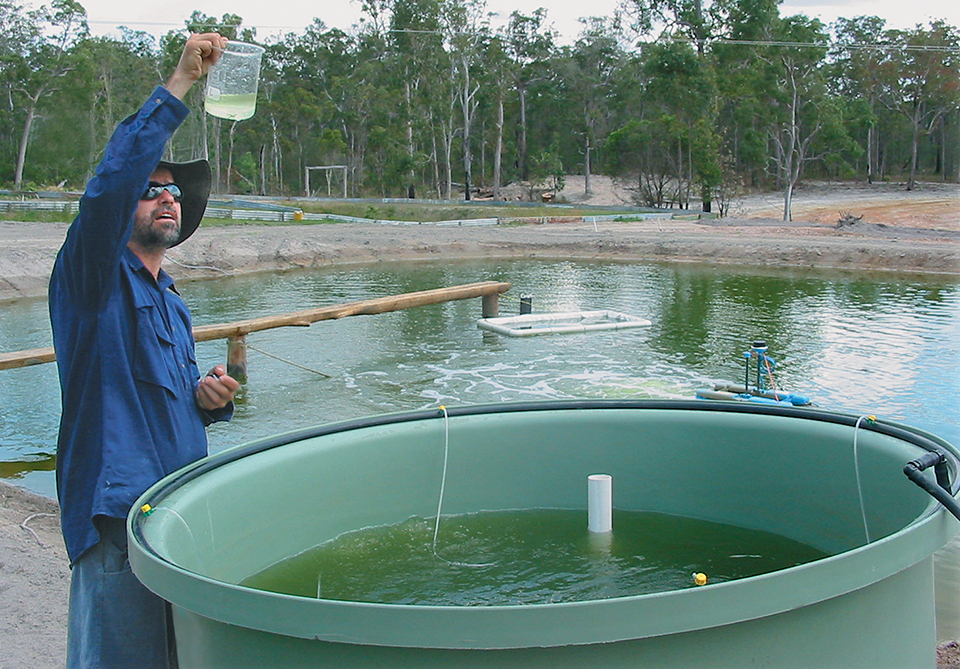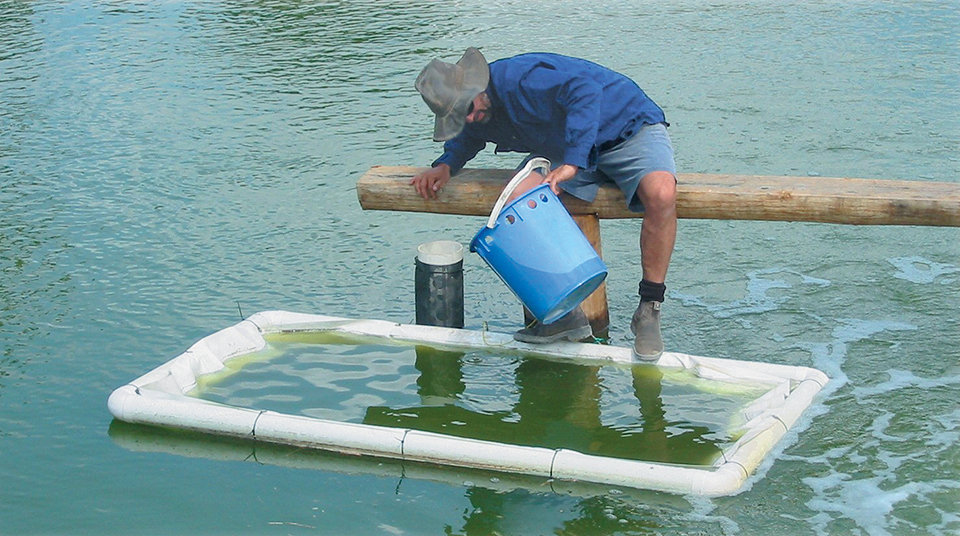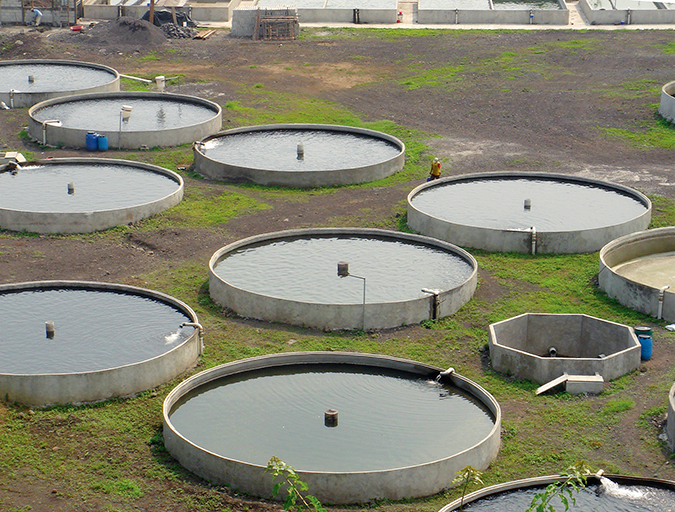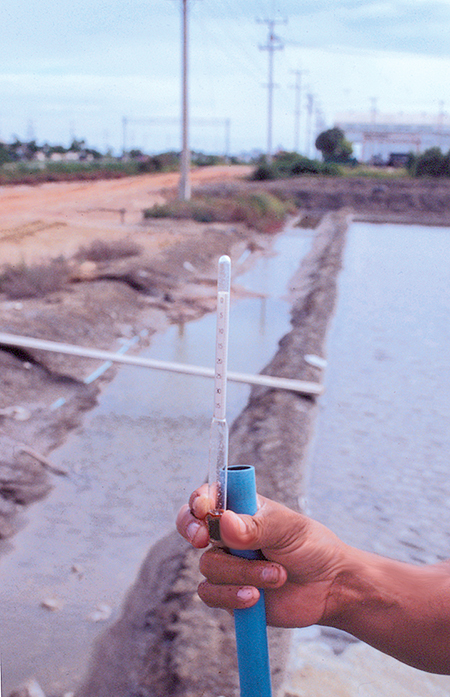Pond study tests P. monodon performance in low-salinity groundwater

With a reputation for high-quality products and strong local demand, prawn farming is one of Australia’s most successful aquaculture industries. However, the limited availability of suitable coastal land and increasingly regulated management requirements have limited the growth of this industry in recent years. The development of inland prawn farming using low-salinity groundwater may allow Australia’s prawn farmers to expand beyond the coastal fringe.
Saline aquifers
Derived from ancient sea floors and accumulated meteoric salts, extensive saline aquifers occur across Australia. Land clearing and large-scale irrigation schemes have raised groundwater levels in many regions, forcing farmers to introduce salt-tolerant crops and farming practices. Not all saline aquifers, however, are suitable for prawn farming, due to the strong influence of local geology on the chemistry of these waters.
Inland trials
In January 2002, a series of trials assessed the suitability of groundwater from inland Australia for the growth of black tiger prawns (Penaeus monodon). The project aimed to determine the viability of inland prawn farming in areas where salt-affected groundwater is both abundant and, at times, problematic.
Initial laboratory trials using a variety of groundwater samples and treatments demonstrated the importance of major ion balance for the survival of P. monodon. Most salt-affected ground-water in Australia is potassium-deficient. This lack of potassium was readily addressed through the addition of potassium chloride.
These initial trials demonstrated that a variety of water sources and types appeared suitable for good survival and growth of P. monodon. A pond-based grow-out trial was subsequently undertaken to determine the performance of P. monodon in low-salinity groundwater in earthen ponds with zero water discharge.
Site selection
An operational aquaculture facility north of Brisbane was selected as the pond trial site because of its favorable local climate, the quality and availability of its groundwater supply, and the present infrastructure. Site soil analysis indicated high clay content suitable for earthen pond construction and water-holding characteristics.
Systems design and preparation
For the trial, four square-shaped earthen ponds with an average size of 330 square meters, a 300-square-meter treatment reservoir, and a 400-square-meter buffer storage were constructed. The treatment and production ponds had an average depth of 1.5 m, while the buffer storage had an average depth of 3 meters when full. Groundwater drawn from a depth of 10 meters was pumped to this buffer storage, where it was degassed and balanced with the addition of potassium chloride prior to pond filling.
The treatment reservoir was used to recycle effluent water back to the production ponds, while providing storage for discharge water during harvest. A 1.5-hp propeller aspirator provided aeration and circulation in the ponds, treatment reservoir and buffer storage.
Water chemistry
The chemical composition of the groundwater supplied to the buffer storage is presented in Table 1. The balance of the major ions remained stable throughout the trial period. The addition of potassium chloride raised potassium levels from 5.9 miligrams per liter to 40 miligrams per liter.
Collins, Chemical composition, Table 1
| Parameter | Value |
|---|
Parameter | Value |
|---|---|
| Conductivity at 25° C | 4,670 uS/l |
| Total hardness as CaCO3 | 461 mg/ |
| Alkalinity as CaCO3 | 130 mg/l |
| Calcium – Filtered | 60 mg/l |
| Magnesium – Filtered | 75.3 mg/l |
| Sodium – Filtered | 888 mg/l |
| Potassium – Filtered | 5.9 mg/l |
Acclimation and stocking
Two separate acclimation and stocking events were carried out. Ponds P1 and P2 were stocked first, with ponds P3 and P4 stocked two weeks later with a new batch of postlarvae (PL).
P. monodon PL15 from a commercial hatchery were held in aerated, 10-cubic-meter tanks for seven days prior to commencing their acclimation to low salinity. The salinity was lowered to 10 ppt using dechlorinated tap water, and then to the target conductivity of 4,670 uS per liter (2.9 ppt) using the site’s groundwater. PL were fed a commercial shrimp diet as well as live artemia nauplii during both the holding and acclimation phases.
Once the target salinity was reached, the postlarvae were stocked into the grow-out ponds at 22 to 25 PL per square meter. During each of the two stocking events, a number of PL were also stocked into floating hapas nets to monitor survival and vigor for two weeks poststocking.
Husbandry and feeding
Feed consumption and prawn health was observed daily during checks of feed trays. Weekly weight checks were also conducted using animals collected from feed trays until the animals grew to a size of approximately 5 grams. After this point, a cast net was used to collect samples. Typically, 50 animals were sampled from each pond, with their pooled weight recorded.
Pond management and water quality

During the trial, conductivity of pond water fluctuated slightly with evaporation and rain events. A midcrop dosage of agricultural lime at 1,000 kilograms per hectare and daily additions of molasses at 4 to 8 ppm were applied to minimize diurnal fluctuations of pH. The water quality parameters of the production ponds, which were measured twice daily, are presented in Table 2.
Collins, Water quality of production ponds, Table 2
| Parameter | Average | Maximum | Minimum |
|---|
Parameter | Average | Maximum | Minimum |
|---|---|---|---|
| Temperature (° C) | 27.6 | 33.1 | 20.4 |
| pH | 8.1 | 10.0 | 6.9 |
| Conductivity at 25° C | 4531 | 5000 | 3437 |
| Dissolved oxygen (mg/l) | 7.0 | 10.6 | 4.8 |
| Secchi (cm) | 45 | 80 | 5 |
Production
All four ponds were harvested at the same time, representing a total grow-out period of 103 and 92 days for the two stocking events (Table 3). Prawns reached an average size of 20.4 grams and an average survival of 56 to 78 percent. PL stocked into the hapas nets indicated mortality of up to 25 percent within the first two weeks following stocking.
Collins, Production cycle and harvest summary, Table 3
| Parameter | Pond 1 | Pond 2 | Pond 3 | Pond 4 | Average |
|---|
Parameter | Pond 1 | Pond 2 | Pond 3 | Pond 4 | Average |
|---|---|---|---|---|---|
| Surface area (m2) | 313 | 368 | 316 | 320 | 330 |
| Growout time (days) | 103 | 103 | 92 | 92 | 97.5 |
| Stocking density (prawns/m2) | 25.5 | 21.7 | 22.1 | 21.8 | 22.8 |
| Average stocked weight (g) | 0.03 | 0.03 | 0.03 | 0.03 | 0.03 |
| Average harvest weight (g) | 19.4 | 19.1 | 21.5 | 21.4 | 20.4 |
| Average growth/week (g) | 1.3 | 1.2 | 1.6 | 1.6 | 1.4 |
| Production rate (tons/ha) | 3.88 | 2.33 | 2.81 | 2.85 | 2.97 |
| Survival (%) | 78 | 56 | 59 | 61 | 63 |
| Feed-conversion ratio | 1.49 | 2.17 | 1.99 | 1.92 | 1.89 |
With an average weekly growth of 1.6 grams, animals from ponds P3 and P4 grew faster those from P1 and P2 (1.3 grams per week). These results represented an equivalent average yield of almost 3 tons per hectare per crop for the four ponds. No signs of parasitic infection or disease were observed.
Market feedback and supply
Following the harvest, the prawns were immediately washed, placed on ice, graded and cooked. The cooked prawns were then stored in iced brine until being sold fresh to local restaurants and seafood wholesalers. Feedback concerning the product’s quality was excellent and highlighted the sweet taste, texture and color of the prawns.
Conclusion
The results of this trial indicated that inland prawn farming can help meet the high demand for fresh, high-quality prawns in Australia. The country’s large, salt-affected groundwater resources can provide regional communities with a productive aquaculture opportunity. Future inland prawn farms would appear to have a ready and accessible market for their products.
(Editor’s Note: This article was originally published in the April 2003 print edition of the Global Aquaculture Advocate.)
Now that you've reached the end of the article ...
… please consider supporting GSA’s mission to advance responsible seafood practices through education, advocacy and third-party assurances. The Advocate aims to document the evolution of responsible seafood practices and share the expansive knowledge of our vast network of contributors.
By becoming a Global Seafood Alliance member, you’re ensuring that all of the pre-competitive work we do through member benefits, resources and events can continue. Individual membership costs just $50 a year.
Not a GSA member? Join us.
Authors
-
Adrian Collins, Ph.D.
Bribie Island Aquaculture Research Centre
Queensland Department of Primary Industries
P.O. Box 2066
Bribie Island, QLD, 4507, Australia -
Benjamin Russell
Bribie Island Aquaculture Research Centre
Queensland Department of Primary Industries
P.O. Box 2066
Bribie Island, QLD, 4507, Australia
Tagged With
Related Posts

Responsibility
Calcium and magnesium use in aquaculture
Aquatic plants and animals get the essential nutrients calcium and magnesium from water and food. Calcium concentrations impact the hydration and development of eggs in a hatchery, where calcium carbonate precipitation can be troublesome.

Responsibility
Reactions between pond bottom soil, water
Alkalinity and acidity in pond water and soil interact and can result in unhealthy culture conditions. Ion exchange occurs between soil and water until an equilibrium is reached.

Responsibility
Salinity balance key to culture success
Outside optimal salinity ranges, aquaculture species have higher feed-conversion ratios, grow at slower rates, become stressed and susceptible to disease, or even die.

Responsibility
Dissolved salts in water for inland, low-salinity shrimp culture
Low-salinity shrimp culture is an important activity in Thailand. Ponds contain water of 2 to 5 ppt salinity, mixing brine solution from coastal seawater with freshwater.


